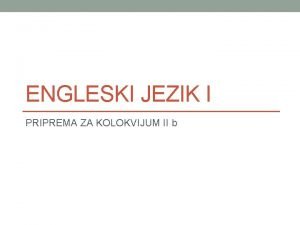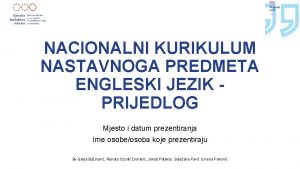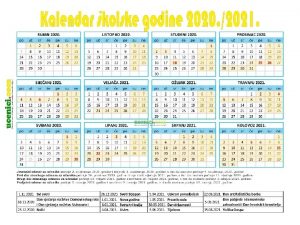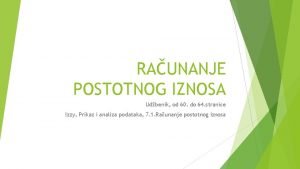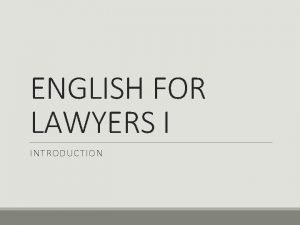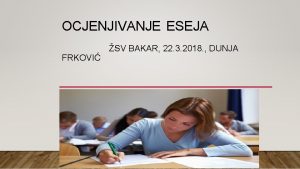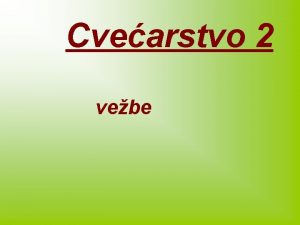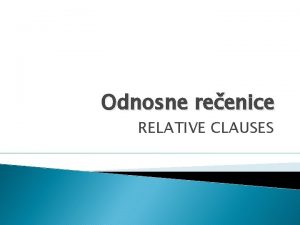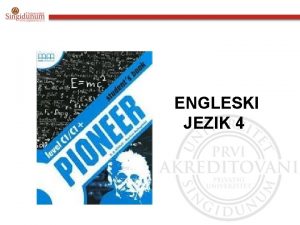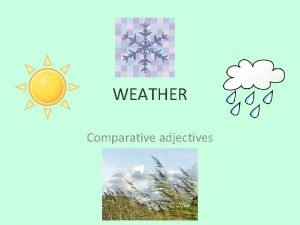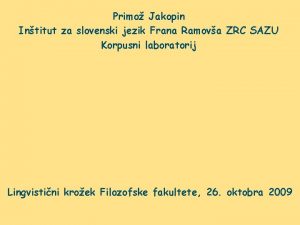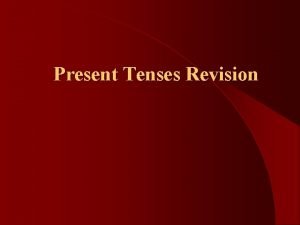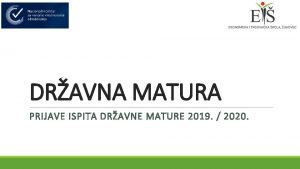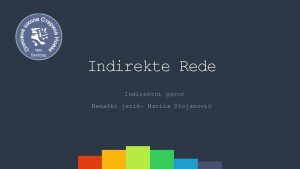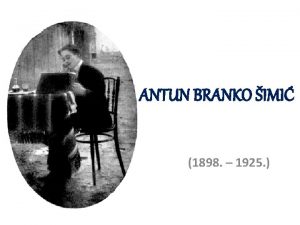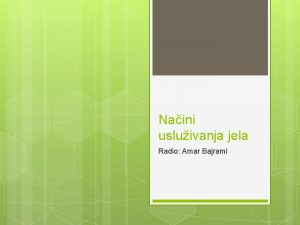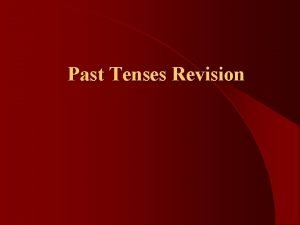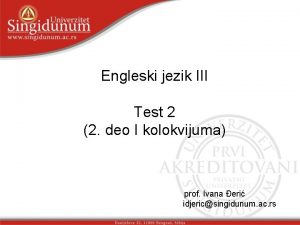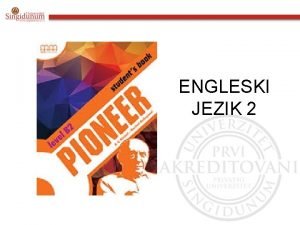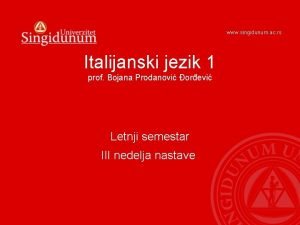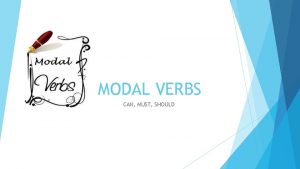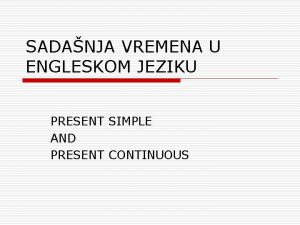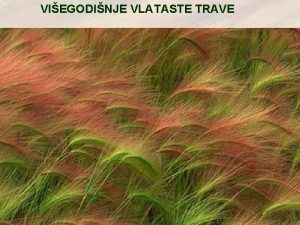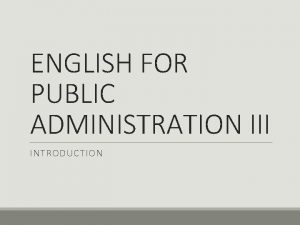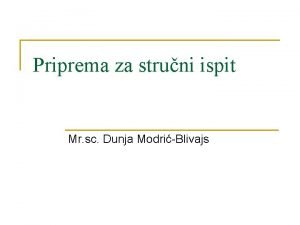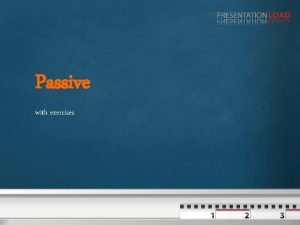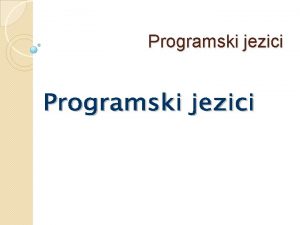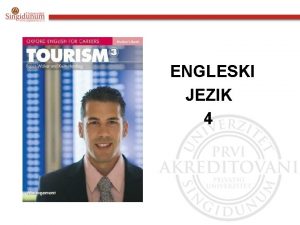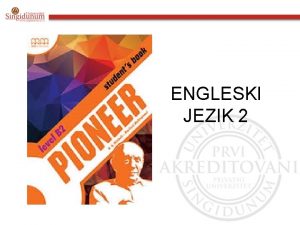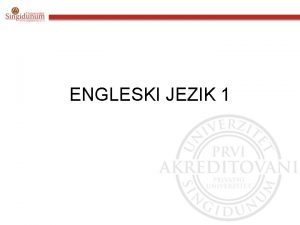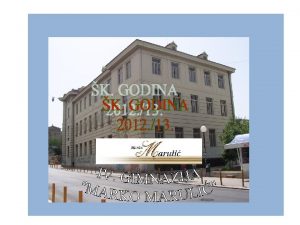ENGLESKI JEZIK STRUKE 3 Uvodni as ponedeljak 25

















































- Slides: 49

ENGLESKI JEZIK STRUKE 3 Uvodni čas ponedeljak, 25. 02. 2018.

ENGLISH FOR ACADEMIC PURPOSES (EAP) English language skills required to study or work in an English-speaking academic context ( at universities)

ACADEMIC LANGUAGE SKILLS o. Listening to lectures and taking notes o. Reading textbooks, research articles, scientific journals, etc. o. Writing essays, seminar papers, examination answers, theses, dissertations, reports o. Attending and comprehending seminars, tutorials, workshops o. Giving academic presentations and lectures (at university courses, conferences, etc. )

EACH ACADEMIC SITUATION HAS… The PRODUCER The AUDIENCE The PURPOSE

WHY STUDY EAP? o. English is the academic lingua franca o. Student and teacher mobility – academic tasks complex for international students o. More and more English-medium instruction courses

READING AND WRITING Academic text types: § STUDENT – TEACHER: seminar papers, theses, dissertations, reports, essays §TEACHER – STUDENT: textbooks, coursebooks §EXPERT – EXPERT/TEACHER/STUDENT: journal articles, conference papers, monographs

ACADEMIC TEXTS HAVE …(1) High lexical density 1. Investment in a rail facility implies a long-term commitment. 2. If you invest in a rail facility this implies that you are going to be committed for a long term. High nominal style 1. The train leaves at 5 p. m. 2. The train’s 5 p. m. departure.

ACADEMIC TEXTS HAVE …(2) Impersonal constructions – avoiding “I” 1. Passive – the solution was found 2. Dummy “it” subjects – it was possible to analyze the problem 3. “Abstract rhetors” – the data suggest; Table 2 shows

ACADEMIC TEXTS AVOID … o. Contractions and phrasal verbs o. Idioms and slang o. Negatives o. Cliché o. Vague language o. Informal and simple language

FOCUS OF THIS COURSE Academic reading, writing and speaking READING: 5 research articles (topic of interest) WRITING: summaries and annotations of the research articles SPEAKING: presentations on academic topics related to the chosen articles

TEACHING MATERIALS §Teacher’s presentations §Authentic texts §Additional teaching material (handouts) §Videos Swales, John M. & Feak, Christine B. Academic Writing for Graduate Students, 3 rd Edition. Essential Tasks and Skills. Michigan ELT, 2012. Thaine, C. et al, Cambridge Academic English. Cambridge: Cambridge University Press, 2012.

WEEK NO. 1 2 TOPIC CONTENT Introduction to EAP academic skills, vocabulary, needs analysis Research article structure, content, purpose, summary 3 Reading techniques Skimming, scanning, intensive and extensive reading 4 Summary Paragraph structure, topic sentence, writing practice 5 Annotated bibliography Instructions, writing practice 6 Writing – sentence level Instructions and practice 7 Presentations Instructions, listening and note taking practice

Week no. Topic 8 - 10 Practice, homework handin and feedback 11 -12 Student’s presentations 13 Final test

ASSESSMENT AND GRADING Attendance 10 Annotated bibliography 40 Presentation 30 Final test 20 TOTAL 100

NEEDS ANALYSIS

ACADEMIC VOCABULARY

ACADEMIC TEXTS INCLUDE: 1. GENERAL VOCABULARY Words also commonly used in everyday life 2. ACADEMIC VOCABULARY Words commonly used in many different academic subjects, but are less common in everyday language 3. SPECIALIZED VOCABULARY Words used mainly in particular academic subject areas, but may be rare in other subjects or in everyday life

DECIDE IF THESE WORDS ARE GENERAL (G), ACADEMIC (A) OR SPECIALIZED (S) analyses likely beyond conclusions debate dicromium different ethnomusicological Hispanic methods necessary proficiency quintuple transformation

SOME ACADEMIC NOUNS analysis data method research aspect definition survey variable approach evaluation emphasis theory concept feature framework hypothesis conclusion evidence outcome insight contribution factor parameters goal criterion formula process phase context function statistics phenomeno n

SOME ACADEMIC VERBS access identify outline assume indicate enable assist occur analyze create obtain provide define survey predict establish demonstrate attribute estimate imply undertake affect

SOME ACADEMIC ADJECTIVES adequate initial available specified considerable sufficient consistent significant approximate dominant potential corresponding relevant constant technical overall

CIRCLE THE CORRECT ANSWER (1): 1. attempt to find out in a systematically and scientific manner: approach / research / variable 2. form or compose: distribute / proceed / constitute 3. a way of doing something, especially a systematic way; implies an orderly logical arrangement: method / process / parameter

CIRCLE THE CORRECT ANSWER (2): 4. a conventionalized statement expressing some fundamental principle: formula / section / structure 5. give evidence of: indicate / respond / major 6. make sense of; assign a meaning to: proceed / interpret / export 7. be subject to change in accordance with a variable: establish / assume / vary

IDENTIFY ACADEMIC WORDS IN THE TEXT William Labov's Social Stratification of English in New York City has made a number of very important contributions to linguistic theory and practice. Among these are the development of the concept of the linguistic variable, which has provided linguists with a means of measuring and describing gradient and variable linguistic features, and the adoption of certain aspects of sociological methodology (particularly sampling and social class index construction), which has permitted a detailed study of the covariation of linguistic and social phenomena. This in turn has enabled us to achieve a clearer understanding of the nature of the relationship between language and various sociological parameters, and increased our knowledge about the social setting of linguistic change. In this paper I want to argue that the linguistic variable, together with a number of methodological and theoretical insights from human geography, can similarly improve our knowledge of the relationship between language and geography, and of the geographical setting of linguistic change.

IDENTIFY ACADEMIC WORDS (KEY) William Labov's Social Stratification of English in New York City has made a number of very important contributions to linguistic theory and practice. l Among these are the development of the concept of the linguistic variable, which has provided linguists with a means of measuring and describing gradient and variable linguistic features, and the adoption of certain aspects of sociological methodology which has permitted a detailed study of the covariation of linguistic and social phenomena. This in turn has enabled us to achieve a clearer understanding of the nature of the relationship between language and various sociological parameters, and increased our knowledge about the social setting of linguistic change. In this paper I want to argue that the linguistic variable, together with a number of methodological and theoretical insights from human geography, can similarly improve our knowledge of the relationship between language and geography, and of the geographical setting of linguistic change.

IDENTIFY ACADEMIC WORDS IN THE TEXT To make political decisions about the extent and type of forestry in a region it is important to understand the consequences of those decisions. One tool for assessing the impact of forestry on the ecosystem is population viability analysis (PVA). This is a tool for predicting the probability that a species will become extinct in a particular region over a specific period. It has been successfully used in the United States to provide input into resource exploitation decisions and assist wildlife managers and there is now enormous potential for using population viability to assist wildlife management in Australia’s forests. A species becomes extinct when the last individual dies. This observation is a useful starting point for any discussion of extinction as it highlights the role of luck and chance in the extinction process. To make a prediction about extinction we need to understand the processes that can contribute to it and these fall into four broad categories which are discussed below.

IDENTIFY ACADEMIC WORDS (KEY) To make political decisions about the extent and type of forestry in a region it is important to understand the consequences of those decisions. One tool for assessing the impact of forestry on the ecosystem is population viability analysis (PVA). This is a tool for predicting the probability that a species will become extinct in a particular region over a specific period. It has been successfully used in the United States to provide input into resource exploitation decisions and assist wildlife managers and there is now enormous potential for using population viability to assist wildlife management in Australia's forests. A species becomes extinct when the last individual dies. This observation is a useful starting point for any discussion of extinction as it highlights the role of luck and chance in the extinction process. To make a prediction about extinction we need to understand the processes that can contribute to it and these fall into four broad categories which are discussed below.

FILL IN THE BLANKS. conducted investigated pointed out compared called for 1. Steers (1956) __________ that even moderate storms can have an impact on coastal development. 2. According to a survey __________ by Ambrosa et al. (2010), expecting medical staff to learn new software us a common reason for failure. 3. Other writers have __________ a change in planning policy. (e. g. Newton, 2008) 4. Carman (1956) __________ the way in which insectuivorous plants catch and digest insects. 5. Dundee at al. (1994) __________ the use of acupuncture and paracetamol in pain relief.

affects alternative consistent focused issues research Much 1)______on how schooling 2)______ individual earnings has 3)______ merely on attainment, or the quantity of schooling, but more recent 4)______ has turned to 5)______ of quality. This 6) ______ focus is 7)______ with the current attention. Policy makers are paying to student testing and accountability in the United States, United Kingdom, and elsewhere.

FILL IN THE GAPS (KEY) Much research on how schooling affects individual earnings has focused merely on attainment, or the quantity of schooling, but more recent research has turned to issues of quality. This alternative focus is consistent with the current attention policymakers are paying to student testing and accountability in the United States, United Kingdom, and elsewhere.

appropriate constraint consumption involve maintain process requires pursue food is one of select the most common and mundane Selecting activities consumers 1)______ several times each day. Nonetheless it often 2)______ taking into account different objectives or goals (e. g. , taste, nutritious value, price), and it may 3) ______ a complicated decision-making 4)______ directed at satisfying these different goals. Whereas it is generally the case that people eat because they need to fulfill their appetite, another major goal many people hold when selecting food is to 5)______ good health. Eating healthy poses a 6)______ on people's food choice: rather than selecting what seems most 7)______ to satisfy their appetite, they need to 8)______ from a subset of foods that are also healthy or skip an opportunity to eat (e. g. , choose small packages to limit their food 9)______; Scott et al. 2008).

KEY Selecting food is one of the most common and mundane activities consumers pursue several times each day. Nonetheless it often requires taking into account different objectives or goals (e. g. , taste, nutritious value, price), and it may involve a complicated decision-making process directed at satisfying these different goals. Whereas it is generally the case that people eat because they need to fulfill their appetite, another major goal many people hold when selecting food is to maintain good health. Eating healthy poses a constraint on people’s food choice: rather than selecting what seems most appropriate to satisfy their appetite, they need to select from a subset of foods that are also healthy or skip an opportunity to eat (e. g. , choose small packages to limit their food consumption; Scott et al. 2008).

COMMON ACADEMIC COLLOCATIONS achieve make (x 2) measure satisfy tackle take ______ needs ______ problems ______ action ______ outcomes ______ progress ______ benefits ______ decisions

considerable significant serious substantial amount attention number interest reduction effect increase change consideration implications consequences challenge number amount increase part

considerable significant serious substantial CONSIDERABLE amount attention number interest SIGNIFICANT reduction effect increase change SERIOUS consideration implications consequences challenge SUBSTANTIAL number amount increase part

ACADEMIC (NOT PHRASAL) VERBS 1. come up - arise 2. come up against - experience 3. cut out - remove 4. find out - discover 5. go together - coincide 6. look into - investigate 7. put off - delay 8. start off - begin 9. think about - consider 10. work out - calculate

ACADEMIC NOUNS - PLURAL FORMS analysis hypothesis phenomenon thesis research index corpus appendix basis species stimulus advice progress information series technology datum

ACADEMIC NOUNS - PLURAL FORMS (KEY) Analysis - analyses Hypothesis - hypotheses phenomenon -phenomena Thesis - theses Research - / Index - indices Corpus - corpora Appendix - appendices Basis - bases species -species Stimulus - stimuli Advice - / Progress - / information - / Series - series technology - / datum - data

HOMEWORK

HOMEWORK o Find a research article on a topic of interest (minimum 8 pages) o Submit by email for review o Read the article o. Make notes about the content of the article o. Print out the article and bring to class next time

HOW TO FIND THE APPROPRIATE ARTICLE? WEB PRINT Anyone on the Web can access and publish Lengthy and complex publication process Publication info tampered with, as well as outside sources, citations, author affiliation Abundance of information easy to search through Clearly indicated publication info Laborious search work

TASK o Search a term in Google, Google scholar and jstor. org o What is the difference between the data obtained?

EVALUATING SEARCH RESULTS DOMAIN NAME EXTENSIONS oanyone can register. com, . net, . org domain names o. edu and. gov can only be used by educational institutions and governmental institutions Academic journals online are nearly always peer reviewed. Websites known as authorities or well-known periodicals.

WIKIPEDIA? Wikipedia is a multilingual, web-based, free-content encyclopedia project supported by the Wikimedia Foundation and based on a model of openly editable content.

BEFORE YOU BEGIN �What credible organizations might have done research into your topic? �What would make someone qualified to speak on your topic?

(RE)SEARCHING IN SERBIA KOBSON SCIndeks

GOOGLE – YES OR NO? Google Scholar Metrics

SOME OTHER CRITERIA TO CONSIDER o Impact factor – for journals o Hirsch Index (H-index) – for authors

HOMEWORK o Find a research article on a topic of interest (minimum 8 pages) o Submit by email for review o Read the article o. Make notes about the content of the article o. Print out the article and bring to class next time
 Osnove zdravstvene struke
Osnove zdravstvene struke Engleski jezik pripreme
Engleski jezik pripreme Maximal 2 radna bilježnica
Maximal 2 radna bilježnica Predmetni kurikulum engleski jezik
Predmetni kurikulum engleski jezik Kurikulum engleskog jezika
Kurikulum engleskog jezika Ponedeljak utorak sreda
Ponedeljak utorak sreda Ponedeljak utorak sreda
Ponedeljak utorak sreda Vez opeke
Vez opeke Future continuous and future perfect objasnjenje
Future continuous and future perfect objasnjenje životinjska stanica dijelovi
životinjska stanica dijelovi Računanje postotnog iznosa
Računanje postotnog iznosa Slaganje vremena u engleskom
Slaganje vremena u engleskom Engleski 1 fon
Engleski 1 fon Glosbe hrvatsko engleski
Glosbe hrvatsko engleski Engleski b razina esej primjer
Engleski b razina esej primjer Paprat engleski
Paprat engleski Odnosne recenice engleski
Odnosne recenice engleski Conditionals engleski
Conditionals engleski Engleski punokrvni konj
Engleski punokrvni konj Comparative and superlative engleski
Comparative and superlative engleski Prevajalnik
Prevajalnik Engleski kviz za 5 razred
Engleski kviz za 5 razred Sadasnja vremena u engleskom
Sadasnja vremena u engleskom Carnet huso prijava
Carnet huso prijava Neupravni govor nemacki
Neupravni govor nemacki Refleksivna pjesma
Refleksivna pjesma Hysni bajrami
Hysni bajrami Word formation engleski
Word formation engleski Ffzg engleski za akademske potrebe
Ffzg engleski za akademske potrebe Word formation objasnjenje
Word formation objasnjenje Zanimljivosti o koprivi
Zanimljivosti o koprivi Sreda na engleskom
Sreda na engleskom Past perfect tense signal words
Past perfect tense signal words Articles engleski vezbanje
Articles engleski vezbanje Matura hrvatski 2018
Matura hrvatski 2018 Causative have objasnjenje
Causative have objasnjenje Word formation engleski
Word formation engleski Modali engleski
Modali engleski Modalni glagoli engleski exercise
Modalni glagoli engleski exercise Prosto sadasnje vreme u engleskom
Prosto sadasnje vreme u engleskom Engleski ljulj
Engleski ljulj Word formation engleski
Word formation engleski Glosbe hrvatsko engleski
Glosbe hrvatsko engleski Engleski b razina esej primjer
Engleski b razina esej primjer Pasiv sa dva objekta engleski
Pasiv sa dva objekta engleski Komparacija pridjeva engleski kviz
Komparacija pridjeva engleski kviz Masinski jezik
Masinski jezik Branimirov natpis
Branimirov natpis Programski jezici
Programski jezici čutilo za okus
čutilo za okus

